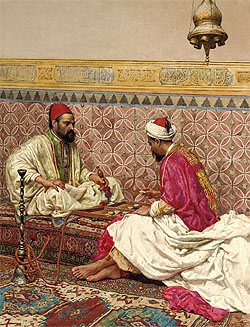|
| Magriel's NYT Columns |
 The California Open, under the direction of Sidney Jackson, was held last weekend in Los Angeles with more than 250 players competing. Aram Kouleyan, the winner of the recent Black and White Classic in Pebble Beach, triumphed again by defeating Shabaz Noovash in a fast-paced 23-point final. Kouleyan rallied from behind, 15 to 6, to tie the score, 22 to 22, and then won the final game at double match point. Top-seeded Charles (Chuck) Papazian defeated Jeff Mervis in the consolation. Roy Springer won the last chance.
The California Open, under the direction of Sidney Jackson, was held last weekend in Los Angeles with more than 250 players competing. Aram Kouleyan, the winner of the recent Black and White Classic in Pebble Beach, triumphed again by defeating Shabaz Noovash in a fast-paced 23-point final. Kouleyan rallied from behind, 15 to 6, to tie the score, 22 to 22, and then won the final game at double match point. Top-seeded Charles (Chuck) Papazian defeated Jeff Mervis in the consolation. Roy Springer won the last chance.
Tournament directors, who often lack the time to compete themselves, played together in a special section. Andre Hoffman took first place in this 31-player field. Two youth tournaments were held concurrently. Mike Fischer won the event for grade-school children; Nilov Farahmand won the high-school section.
Most backgammon tournaments, like tennis tournaments, use a “knockout” format whereby in each round one half the players are eliminated and the other half advance to the next round. The outcome of a match often hinges on one game in which every roll and every play is significant. A single mistake in such a game can eliminate a player from competition, as one young player (Black) found out in the diagrammed position.
|
| Black to play 4-3. |
|
|
|
In effect, Black and White are racing each other; Black wants to see whether he can bring down reinforcements to his home board before White can establish a point there. By stopping to hit a third man on the other side of the board, Black actually gave White a vital extra tempo in his life-or-death struggle to come in and make a point. Picking up the third man at this time is irrelevant to Black’s attack scheme. Besides, Black is almost certain to be able to hit it later.
The extra builder on the 9-point significantly increases Black’s chances to press home his advantage by quickly making the 4 and 5 points. On the next roll, for example, Black will have 25 combinations, out of 36 possible, to make one of these points instead of 15 combinations without a man on the 9-point.
Rollout
 Tom Keith 2013 |
|
Money play White owns 2-cube Black rolls 4-3 5184 games with VR Checker play: 2-ply Cube play: 3-ply Red |
| 4-3: | Game | G | BG | Equity | ||||
| 1 | 24/20*, 13/10* |
W L |
.8081 .1919 |
.7067 .0356 |
.0169 .0015 | +1.2249 |

| (a) |
| 2 | 13/9, 13/10* |
W L |
.7971 .2029 |
.7095 .0421 |
.0136 .0019 | +1.1825 | (0.0424) | (b) |

|
|

